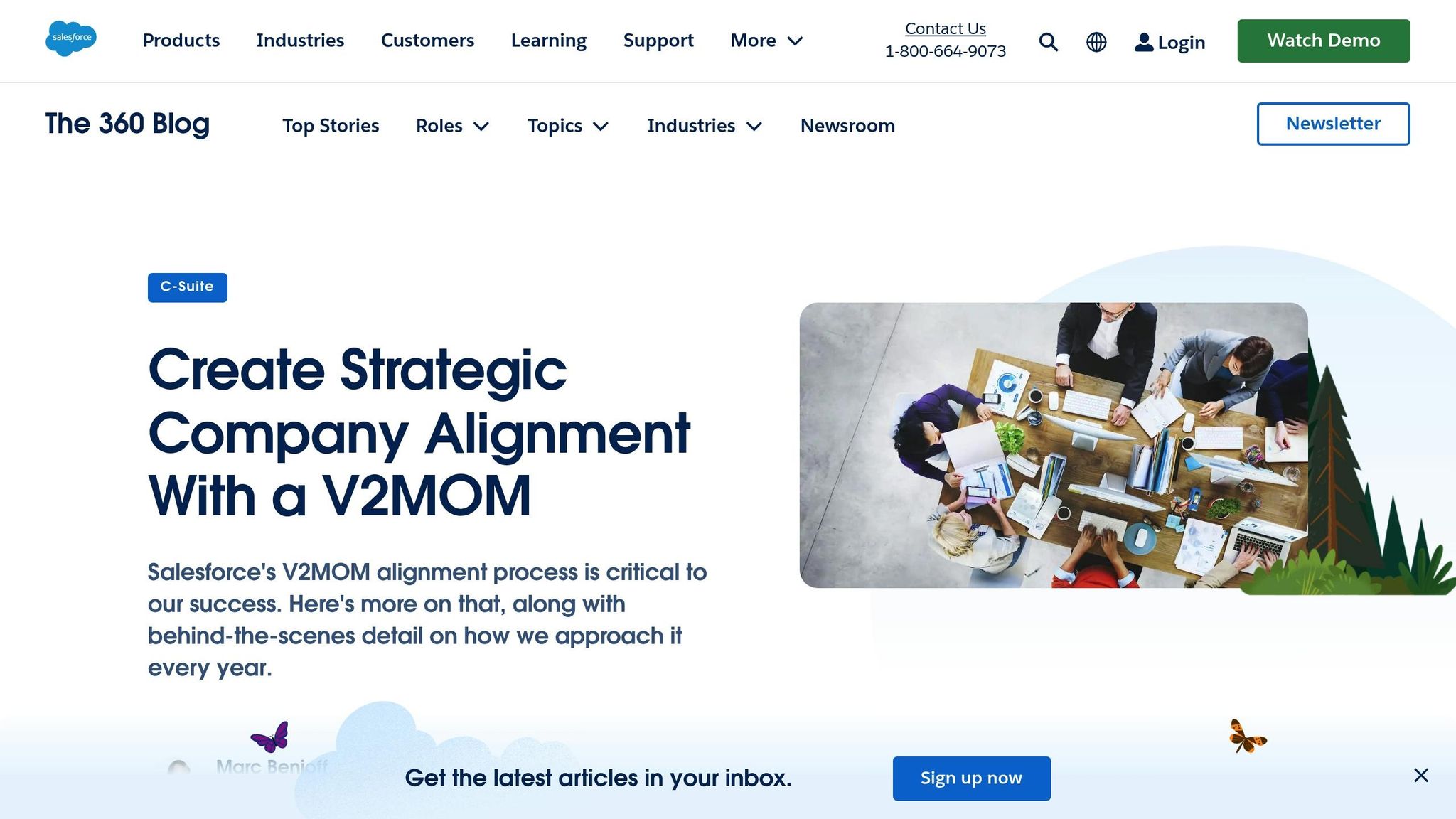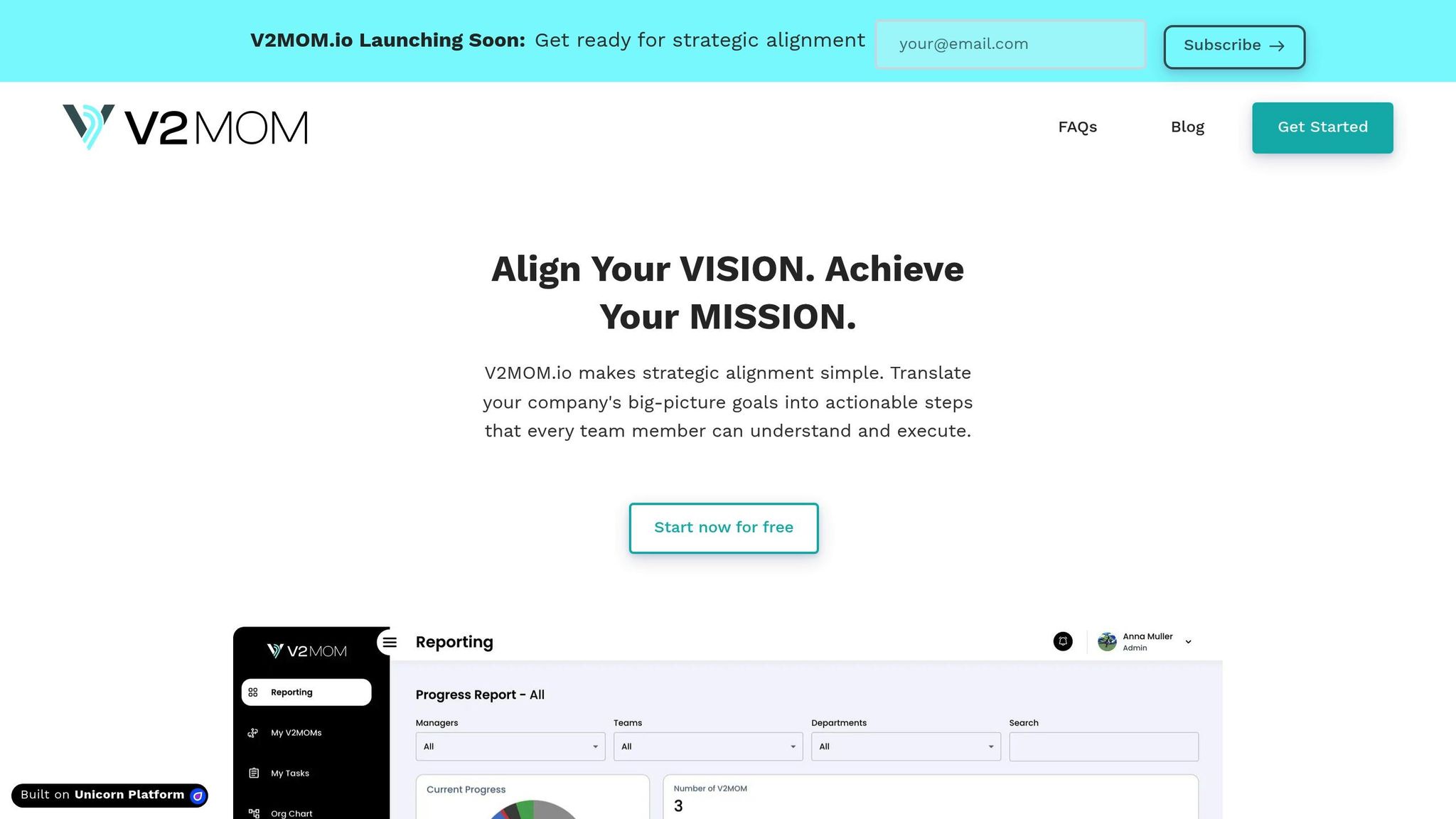The V2MOM framework is a simple way to turn big-picture goals into measurable results. It focuses on five areas: Vision, Values, Methods, Obstacles, and Measures. By defining these clearly, you can create metrics that align with your goals and track progress effectively. Here’s a quick overview:
- Vision: What’s your ultimate goal?
- Values: What principles guide your decisions?
- Methods: What strategies will you use?
- Obstacles: What challenges might you face?
- Measures: How will you track success?
To make this work, focus on SMART metrics (Specific, Measurable, Achievable, Relevant, Time-bound) and balance lead indicators (predict future results) with lag indicators (track outcomes). For example, track Customer Satisfaction Score (CSAT) to measure service quality or employee training hours to predict future performance.
Tools like V2MOM.io simplify this process, offering features like real-time dashboards, automated reporting, and team collaboration. Whether you’re a small team or a large company, this framework helps connect daily tasks to long-term goals.
V2MOM Framework | How to set goals using V2MOM | Project ...

Creating Metrics Using V2MOM
Now that we’ve established the framework, it’s time to translate the vision into measurable goals.
Turning Vision into Measurable Goals
Break down your vision into specific, quantifiable targets that align with your strategic objectives. For example, if your goal is to excel in customer service, focus on metrics like Customer Satisfaction Score (CSAT), first response time, issue resolution time, and quarterly customer retention rates.
Every metric should align with the SMART criteria: Specific, Measurable, Achievable, Relevant, and Time-bound. This ensures you have clear benchmarks to track progress effectively.
Understanding Lead vs. Lag Indicators
Knowing the difference between lead and lag indicators helps connect your goals to measurable outcomes.
- Lead indicators are forward-looking and help predict future performance.
- Lag indicators show results after the fact, reflecting outcomes.
| Indicator Type | Purpose | Examples | Tracking Frequency |
|---|---|---|---|
| Lead | Predict future performance | Employee training hours, Sales pipeline value, Customer engagement rate | Daily/Weekly |
| Lag | Measure achieved results | Revenue growth, Customer churn rate, Project completion rate | Monthly/Quarterly |
A good balance of lead and lag indicators ensures you can make proactive adjustments while also verifying the effectiveness of your strategy.
Using Data to Set Metrics
- Collect several months of historical data to understand your starting point.
- Standardize data collection processes with clear roles, quality checks, and automation where possible.
- Use baseline data to set progressive targets, defining small, actionable steps to close performance gaps.
Leverage digital tools for real-time tracking to keep everyone aligned and make adjustments as needed. With clear metrics and reliable data, you can set practical steps to improve performance steadily.
Implementing Metrics in Daily Work
Once you've set clear, measurable goals, it's time to incorporate these metrics into your daily operations.
Linking Metrics to Projects
Tie your V2MOM metrics directly to project goals by assigning ownership and setting milestones. Each project should have specific metrics that connect to your overall organizational objectives.
Here's an example of how metrics can cascade from high-level goals to individual tasks:
| Level | Metric Type | Frequency | Owner |
|---|---|---|---|
| Strategic | Company-wide KPIs | Quarterly | Executive Team |
| Tactical | Department Goals | Monthly | Department Heads |
| Operational | Project Milestones | Weekly | Project Managers |
| Individual | Task Completion | Daily | Team Members |
Setting Up Review Schedules
Establish a regular review routine to monitor progress. The goal is to check in often enough to catch issues early while giving teams enough time to make meaningful strides.
Here’s a suggested review schedule:
-
Daily Stand-ups
Keep these short (no more than 15 minutes) to address immediate progress and obstacles. Focus on operational metrics that impact daily tasks. -
Weekly Team Reviews
Spend about 60 minutes reviewing project-specific metrics and adjusting short-term plans. This is a great time to identify trends and make necessary tweaks. -
Monthly Strategic Reviews
Set aside 2 hours to evaluate overall progress and ensure department-level goals are still aligned with the company’s objectives.
Building Team Alignment
To make metrics work, everyone on the team needs to understand their role in achieving broader goals. Transparency and shared accountability are key.
Clear Communication Channels
- Use a central dashboard to track metrics in real time.
- Hold regular cross-functional meetings to address interdependencies.
- Document how metrics are defined and calculated to avoid confusion.
Engaging the Team
- Involve team members in setting metrics and celebrate milestones together.
- Treat metrics as tools for improvement, not as a way to assign blame.
"V2MOM.io helps teams stay aligned by visualizing a company's vision, values, methods, obstacles, and measures in one central hub." [1]
sbb-itb-ee93501
Using V2MOM.io for Metric Management

V2MOM.io simplifies and automates the process of tracking metrics, making daily monitoring more efficient and centralized.
V2MOM.io Tracking Tools
With V2MOM.io, managing metrics becomes effortless. The platform combines all your key performance indicators in one place, offering real-time tracking without the hassle of manual data compilation.
Here’s what it offers:
| Feature | Purpose | Benefit |
|---|---|---|
| Centralized Dashboard | View metrics in real time | Instant access to performance data |
| Team Collaboration Tools | Align across teams | Improved communication and teamwork |
| Built-in Analytics | Analyze data effectively | Better decision-making |
| Custom Reporting | Track metrics your way | Tailored to your business needs |
Digital vs. Manual Tracking
Manual tracking often results in errors and delays. V2MOM.io overcomes these issues with automated data collection and analysis.
Here’s a comparison:
| Aspect | Manual Tracking | Digital Tracking with V2MOM.io |
|---|---|---|
| Data Accuracy | Susceptible to errors | Automated and reliable |
| Update Frequency | Weekly or monthly | Real-time updates |
| Accessibility | Local files only | Accessible from anywhere |
| Analysis Capability | Basic calculations | Advanced analytics |
| Time Investment | Time-consuming | Low effort |
By switching to V2MOM.io, you can save time and gain more accurate insights into your metrics.
Setting Up V2MOM.io
Getting started with V2MOM.io is simple and flexible, accommodating businesses of all sizes.
- Starter Plan: Ideal for smaller teams, supporting up to 10 users and 3 teams at no cost [1].
- Business Plan: Designed for larger organizations, offering unlimited users, advanced features, and comprehensive support [1].
Follow these steps to set it up:
-
Define metrics structure
- Choose key performance indicators.
- Determine how often metrics will be measured.
- Set up reporting hierarchies.
-
Configure user access
- Assign roles within your team.
- Organize departments.
- Establish permission levels.
-
Customize dashboards
- Add widgets that matter to you.
- Create personalized views.
- Enable automated reporting.
These steps ensure V2MOM.io is tailored to your organization’s needs, helping you manage metrics efficiently.
Solving Common Metric Challenges
Getting Team Buy-in
To get your team on board, start with a clear vision and strategy. Lay out your company’s vision, values, methods, challenges, and goals in one accessible place. This helps everyone understand how their role contributes to overall business success. Tools like V2MOM.io can simplify this process by making your framework easy to share and follow. Gaining team support early is key to reducing resistance and ensuring data quality. Tackling these challenges upfront leads to smoother metric adoption across teams.
Conclusion
The V2MOM framework helps businesses succeed by connecting metrics to your vision, values, methods, and potential challenges. It focuses on turning your vision into measurable goals, creating a clear path toward achieving results.
Managing metrics effectively ties long-term goals to everyday operations. This structured approach lays the groundwork for using digital tools to simplify and enhance the process.
Tools like V2MOM.io make it easier to manage metrics in real time. By centralizing vision alignment and progress tracking, teams can monitor metrics while staying focused on larger organizational objectives. Its collaborative features ensure everyone knows what they’re measuring and why it’s important. With technology simplifying workflows, staying aligned with strategic goals becomes much easier.
Consistency and alignment at all levels are crucial for creating effective custom metrics. Whether you're a small team using a free plan or a large enterprise utilizing advanced features, the V2MOM framework offers the structure needed to turn strategic visions into measurable outcomes. Regular reviews and clear communication further strengthen this process.
Implementing metrics is an evolving process. As your business grows, your metrics should adapt too. By applying the V2MOM framework and using the right tools, organizations can foster a culture of data-driven decisions that supports long-term growth.
FAQs
How does the V2MOM framework align individual tasks with a company's long-term goals?
The V2MOM framework ensures alignment by clearly defining a company's vision, values, methods, obstacles, and measures. This structured approach helps teams understand how their individual tasks contribute to broader organizational objectives.
By creating a shared focus and prioritizing transparency, V2MOM fosters collaboration and keeps everyone on the same page, enabling measurable progress toward long-term goals.
Why is it important to use both lead and lag indicators when creating metrics with the V2MOM framework?
Combining lead indicators and lag indicators in the V2MOM framework helps businesses create more effective and actionable performance metrics. Lead indicators focus on predictive, forward-looking measures that can influence outcomes, such as customer inquiries or employee training hours. Lag indicators, on the other hand, measure past performance, like revenue achieved or customer retention rates.
By using both types of indicators, you can gain a more comprehensive view of your progress. Lead indicators allow for proactive adjustments to stay on track, while lag indicators provide clarity on whether your strategic goals have been met. Together, they ensure that your metrics are both predictive and reflective, driving smarter decisions and better alignment with your business objectives.
How does V2MOM.io simplify tracking and managing business performance metrics?
V2MOM.io streamlines the process of tracking and managing performance metrics by centralizing your vision, values, methods, obstacles, and measures in one platform. This ensures your entire team stays aligned with your strategic goals.
The platform provides tools for real-time progress monitoring, collaboration, and data-driven insights, making it easier to adapt and refine strategies as needed. Its flexibility and customization options make it suitable for businesses of all sizes, helping them focus on what truly drives success.


